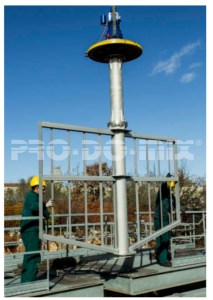What is wastewater treatment?
The chemical and physical treatment of wastewater is a complex process, which consists in conveying it into public sewers or the environment without polluting.
The chemical-physical treatment is part of the process and is divided into various mechanical, physical, and chemical stages:
- flash mixing
- coagulation
- flocculation
High-quality agitation solutions ensure high-quality output water. That’s why PRO-DO-MIX® has developed a complete range of agitators suitable for all water-treatment stages, including flash mixing, coagulation, and flocculation. One of our most important installations was designed and built for the Sulaibiya Wastewater Treatment and Reclamation Plant in Kuwait City. The challenge here was to keep within the strict deadlines required by the EPC.We installed them in 2018, and they have been working smoothly since February 2019. We have hundreds of these installations worldwide.
Flash Mixing, Coagulation, and Flocculation
Flash Mixing, Coagulation, and Flocculation are essential for treating industrial and municipal wastewater, which may contain colloidal solids, e.g., particles that are too small or light to filter and eliminate. Flash mixing, coagulation, and flocculation are crucial for promoting sedimentation and agglomeration in larger particles. What does this mean? Let’s delve deeper into this topic.
Flash Mixing and Coagulation in water treatment
The flash (or rapid) mixing and coagulation stages consist in adding chemicals to raw water to foster coagulation while attracting particles that doesn’t settle or cannot be filtered. Coagulants, such as ferric chloride (FeCl3), PAC (poly aluminium chloride Al2Cl(OH)5), aluminium sulphate (Al2(SO4)3), attract these particles, so it will be easier to agglomerate them during flocculation.
The duration of the flash mixing and coagulation stages determines the quality of the whole process. For example, a short retention time won’t allow the homogeneous distribution of the chemicals within the basin, making the reaction unsuccessful. Therefore, the residence and contact time must be calculated accurately, considering the main parameters, such as the basin’s volume and the water’s flow rate.
Vertical agitators are the only solution possible at this stage (as well as during the flocculation stage) as they cannot be combined with other agitation solutions like submersible mixers. Our vertical agitators are efficient during the flash mixing and coagulation stages as they quickly and thoroughly agitate the chemicals in raw water before releasing them into the flocculation chamber. Our high-efficiency impellers are designed for the flash mixing and coagulation stages: PRO-DO-MIX® 3PM-0134 HURRICANE and 3PM-0030 EVOLUTION impellers help ensure optimal rapid mixing and coagulation, thanks to their high hydrodynamic profile that generates a high flow rate, thus ensuring minimum energy consumption.
What is flocculation in water treatment?
Flocculation takes place after the flash mixing and coagulation stages. During this stage, the particles removed from the water are taken to larger agglomerations, called flocs. This way, they can settle down in the sedimentation chamber and be separated by the water conveyed to the drain. This step is possible thanks to the reaction with a polymeric solution, which acts as a flocculant agent, such as polyelectrolytes or polyamines.
Flocculation agitators must be engineered carefully to ensure effective flocculation, which must take as little time as possible, consume as little energy and chemicals as possible, and ensure high-quality output water. As with flash mixing and coagulation, the agitator’s design is a crucial point. Flocculation needs effective and homogeneous agitation to promote floc formation and contact. Moreover, it must be gentle to prevent the flocs from breaking. That’s why maximising the impeller’s flow rate while minimising the shear speed is so important.
PRO-DO-MIX® 2PM-0650 PREMIUM impeller is engineered for agitation during flocculation, where flocs are delicate, and flow must be smooth. Its design allows a high flow rate to reach all the basin’s areas. This way, we avoid dead spots, including the basin’s bottom and corners, keeping all flocs suspended. The large blade surface and curved design allow for gentle yet effective blending, promoting floc agglomeration.
Combined with our flocculation agitators, the variable speed drive controls the mixing speed during the treatment process. This way, the operator can control the process and adjust the output speed based on the needs, optimising the mixing performance. That’s why it’s highly recommended.
High Efficiency Flocculation Impeller VS Gate Type Agitator

Gate type agitator

High efficiency flocculation impeller
Our high-efficiency impellers ensure efficient flocculation. They provide numerous advantages, especially if compared with the gate-type ones, which are mainly used in old municipal treatment plants and considered suitable due to their low speed and shear capacity. However, we’d like to show why PRO-DO-MIX® agitators with 2PM-0650 Premium impellers should be preferred to ensure an efficient production process.

First of all, gate-type agitators have an obsolete and inefficient design, resulting in high installed power due to its high energy consumption. Moreover, multiple, robust and heavy bulkheads complicate the installation. This causes mechanical problems due to the excessive load on the agitator’s drive unit, resulting in frequent maintenance or replacements.Moreover, these impellers don’t have a high flow rate or a controlled peripheral speed. They don’t even ensure proper contact between flocs and sludge. The result is a simple, massive circular motion.

In contrast, PRO-DO-MIX® 2PM-0650 PREMIUM agitator with a high-efficiency design, combined with light construction, reduces the installed power considerably because it absorbs less power. It also minimises mechanical stress, eliminating the need for maintenance and plant downtimes. From the process perspective, our PRO-DO-MIX® 2PM-0650 PREMIUM impeller ensures a high flow rate and low peripheral speed, thanks to its high hydrodynamic profile with large blades, which ensure low shear, keeping the flocs intact. The flocculation that results from the regular bottom-up flow promotes floc agglomeration and suspension, thus improving the flocculation process. We ensure excellent flocculation without exceeding a peripheral speed of 2m/s.
No comments:
Post a Comment